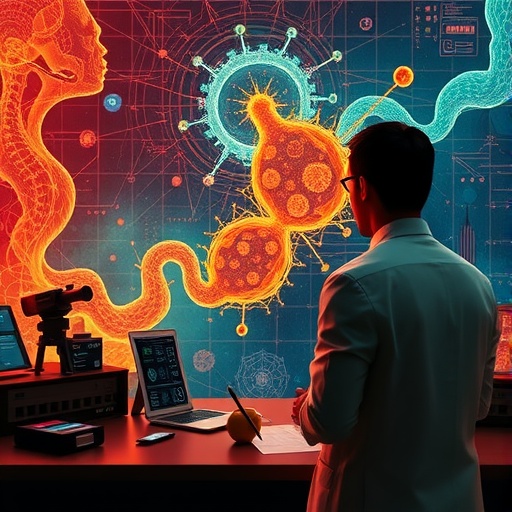For many, memories serve as an archive of our past, each imbued with unique sensations and emotions that define our personal narratives. Yet among these recollections, some stand out with a striking vividness—a quality that allows individuals to relive moments as if they were unfolding anew. This phenomenon, known as vivid memory, has captivated scientists and humanities scholars alike, prompting a collaborative investigation aimed at unlocking the mechanisms behind these richly detailed cognitive experiences.
Researchers at the Universities of Cambridge and Durham have embarked on a pioneering study that transcends traditional disciplinary boundaries. By uniting cognitive neuroscience with insights drawn from humanities, the team aspires to redefine the understanding of vivid memory, expanding beyond the conventional emphasis on visual imagery to capture a broader spectrum of sensory and emotional dimensions. This interdisciplinary approach is poised to yield a nuanced comprehension of how vivid memories manifest across different individuals and evolve through time.
To gather comprehensive data, the research team has launched an extensive online survey, inviting participants from a diverse demographic to recount two of their most vivid personal memories. The ambition is to assemble a large, anonymized database that can represent the population’s varied experience with memory. By capturing such a vast array of recollections, the project seeks to uncover patterns and commonalities that may explain variations in memory vividness and durability.
Central to this endeavor is the hypothesis that vivid memories are not solely visual constructs but are richly textured by multisensory input and emotional resonance. Collaborators in the humanities have brought forth historical and literary frameworks, including examinations of Shakespearean texts and early British autobiographies, to inform an enriched definition of vivid memory that encompasses tactile, auditory, olfactory, and affective components. This holistic perspective challenges the dominant neuroscientific paradigm and introduces innovative dimensions to memory research.
The integration of humanities with scientific methodologies is exemplified by Dr. Kasia Mojescik of Cambridge’s Department of Psychology, who highlights the unprecedented collaboration that melds experimental neuroscience with cultural and historical scholarship. By doing so, the project aims not only to map the phenomenology of vivid memory but also to account for how cultural narratives and language shape the way we remember.
Professor Charles Fernyhough of Durham University emphasizes that historic and literary inquiry unveils facets of remembering often overlooked in empirical research. Emotions, the subjective sense of reliving, and the feeling of presence within a memory have typically been marginalized in quantitative studies. By incorporating narrative analysis and textual interpretation, this project broadens the scope to include affective and experiential richness as integral components of vivid memory.
Armed with an unprecedented data corpus, the research team employs state-of-the-art machine learning algorithms to identify recurring themes and predictors of vividness across age groups. Such computational analysis enables the detection of subtle patterns in memory reports, revealing how specific qualities correlate with longevity, emotional intensity, and identity formation. This data-driven approach fosters new hypotheses about the cognitive and neural substrates underlying memory vividness.
One intriguing aspect under scrutiny is the paradox of aging and memory. While aging is generally associated with cognitive decline and reduced recall precision, many individuals maintain remarkably vivid recollections of formative or emotionally significant events. By dissecting these enduring memories, the project aims to understand how subjective vividness is preserved despite neurological changes, possibly illuminating mechanisms for protective or compensatory processes in the aging brain.
The project also undertakes a diachronic exploration of vivid memory, tracing shifts over centuries by examining early autobiographical writings from the sixteenth to eighteenth centuries. This historical perspective reveals how cultural constructs and autobiographical practices have transformed the representation and experience of vivid memories over time. Such findings hold implications for contemporary understandings of memory as a socially and historically situated phenomenon.
Guided by project lead Professor Jon Simons of Cambridge, the team conceptualizes vivid memory as a form of mental time travel, wherein individuals can re-experience past events with profound sensory and emotional fidelity. This framework aligns with advances in cognitive neuroscience highlighting the dynamic interplay between episodic recall, self-referential processing, and emotional salience. Their work seeks to refine this conceptualization by injecting humanities-derived insights.
Beyond theoretical advances, the research holds promising applications for clinical domains. Understanding the mechanics of vivid memory could potentiate breakthroughs in therapeutic strategies targeting memory impairments, such as those experienced in neurodegenerative diseases or psychiatric conditions. Furthermore, enriched knowledge of how memories become vividly encoded and persist might inform the development of novel pharmacological agents aimed at enhancing memory fidelity.
Crucially, the success of this ambitious project hinges on public engagement. Researchers invite individuals of all ages and backgrounds to contribute their memories via an accessible online survey. This participatory approach not only democratizes scientific inquiry but also ensures that the data reflects a rich tapestry of human memory experience, thereby enhancing the generalizability and impact of the findings.
In summary, this innovative cross-disciplinary investigation ventured by the Universities of Cambridge and Durham promises to revolutionize our understanding of vivid memory. By amalgamating cutting-edge neuroscience, sophisticated machine learning, and deep humanities scholarship, the project embarks on an unparalleled journey to unravel the complex, multisensory nature of how we remember in vivid detail across the spectrum of human experience and history.
Subject of Research: People
Article Title: Exploring the Multisensory Dimensions of Vivid Memory through Interdisciplinary Inquiry
News Publication Date: Not specified
Web References: Survey Link
Image Credits: University of Cambridge
Keywords: vivid memory, cognitive neuroscience, humanities collaboration, mental time travel, autobiographical memory, sensory experience, memory aging, machine learning, episodic recall, memory research




